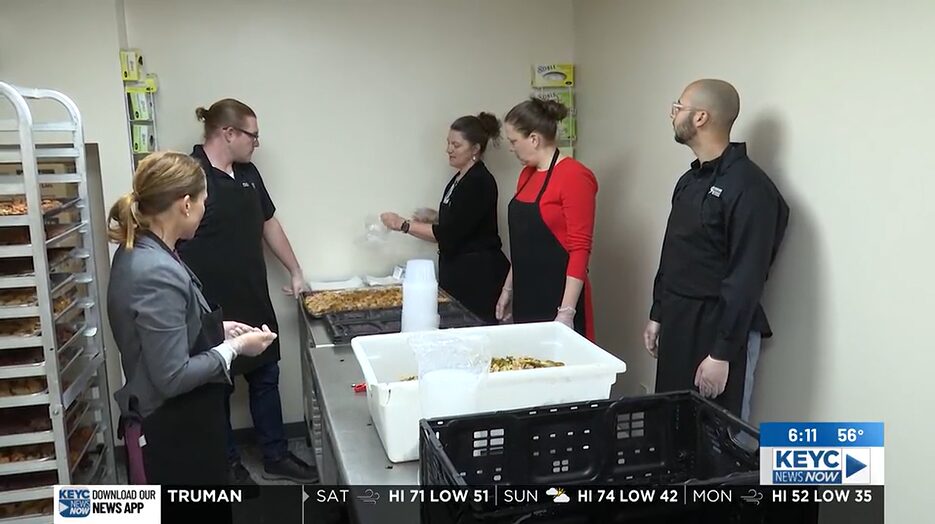Region Nine Development Commission, in partnership with the Agricultural Utilization Research Institute, the Minnesota Department of Agriculture, and FoodOps, is conducting a survey to identify food and beverage manufacturing trends to support growth in these and related sectors. The goal of the survey is to help create an increased economic impact for the entire state.
The project is in response by the AURI to an apparent lack of capacity or access to affordable, right-sized manufacturing options in Minnesota for growing, ready-to-scale small food and beverage businesses. Failure to address these infrastructure needs places the state at risk of losing not only the economic benefit these businesses provide today such as jobs, revenue, capital, and agricultural product utilization, but also minimizes the economic potential of attracting new food and beverage businesses to the state.
Survey Participants:
The intended audience of this survey are those in the food and beverage manufacturing sectors within the state of Minnesota, regardless of annual sales volume, that is defined by the standard industrial classifications system, Food and Kindred Products used by the United States Department of Labor.
Anticipated Project Benefits to Minnesota:
• Identification of the real and perceived strengths, weaknesses, opportunities, and threats faced by food and beverage manufacturers and related sectors.
• Potential increases in employment and income in all sectors tied to the food and beverage manufacturing sectors, which may result in economic growth for the state.
• Ability to gain resilience in all related sectors by understanding what opportunities and threats exist, how those challenges could be mitigated, and opportunities pursued.
• Identification of opportunities for domestic and international investment benefits in Minnesota by adding the state’s economic growth and resilience.
• Food and beverage manufacturers of all sizes benefit from a study of their environment and new data resources and guides.
• Minnesota will benefit by identifying ways to potentially grow the food and beverage manufacturing sector, which may result in economic growth in multiple related industrial sectors.
• Creation of an assessment report to support the expansion of mid-sized companies with sales from $20,000 to $3 million as well as related industrial sectors.
• Provide assistance and insight to the state legislature in crafting and refining policies which offer the right amount of regulation and support to maintain level opportunities for all.
Access the Survey:
The survey is currently open and will be available to participants until February 5, 2020. To participate in the survey, please visit https://www.rndc.org/food-and-beverage-manufacturing-assessment/
For specific questions regarding the survey or study, please contact Shawn Schloesser at shawn@rndc.org or 507.389.8886.
 MPCA Speaks of Benefits of Reducing Food WasteApril 16, 2025 - 3:33 pm
MPCA Speaks of Benefits of Reducing Food WasteApril 16, 2025 - 3:33 pm RNDC Receives $100,000 Grant for Regional Effort to Rescue Surplus Food for Food ShelvesDecember 20, 2024 - 11:42 am
RNDC Receives $100,000 Grant for Regional Effort to Rescue Surplus Food for Food ShelvesDecember 20, 2024 - 11:42 am Beyer named deputy director for Region Nine Development CommissionDecember 20, 2024 - 10:48 am
Beyer named deputy director for Region Nine Development CommissionDecember 20, 2024 - 10:48 am

February 2020 E-Newsletter
in Newsletter/by Region NineRead Now
Spotlight Interview with Nicole Griensewic Mickelson
in News/by Region NineListen to the KTOE interview.
School board shares info
in News/by Region NineRegion Nine Development Commission looks for solutions in food and beverage manufacturing capacity challenges
in News/by Region NineMANKATO, Minn. (KEYC) – An agriculture group now finds an apparent lack of capacity for growing Minnesota food and beverage manufacturers to expand when they are ready.
That finding from the Agricultural Utilization Research Institute has prompted a new study from the Region Nine Development Commission to understand what the problems are and what can be done to solve them, according to Region Nine Community and Business Development Specialist Shawn Schloesser.
Region Nine said that if these infrastructure needs are not addressed, there is a risk of losing both the economic benefits that they provide and the possibility of attracting new businesses to the state.
“If you have a product, and you want to manufacture 1,000 of them, but the company that will do that for you will only manufacture 10,000, that gap is too hard for you to close, and so we’re looking for manufacturers that are willing to take on various sizes, the right size for your company,” Schloesser said.
Schloesser said Region Nine is hoping to make small adjustments in the state.
“Whether or not there are things that the State Legislature could do, such as adjustments to regulations,” he said.
The organization, along with AURI, the Minnesota Department of Agriculture and FoodOps, are looking at various trends in their survey.
The goal is to support growth in the industry and create a positive economic impact for the state by looking at strengths, weaknesses, opportunities and threats faced by those in the sector.
“So we’re looking at the licensing portion from the state, the regulations that are in place,” Schloesser said.
Sourcing local ingredients is another trend they are looking at, something Jack Link’s in Mankato tries to do as often as possible, according to Plant Manager Richard Achtziger.
The Mankato location produces roughly 225,000 sticks a week.
As employees work behind the scenes, Achtziger is noticing trends in the industry.
“People are trying to get to the clean label, which is one of the things that we’re doing here as well. As close to pure as you can get,” he said.
Achtziger is also noticing the trend in sourcing local ingredients, something he said there are challenges with.
“It’s not always possible. As I said, it’s a tough market right now, trying to get beef in,” Achtziger said.
The survey is aiming to help mid-sized companies, particularly those with sales from $20,000 to $3 million.
But Region Nine is seeking responses from all state food and beverage manufacturers and hopes to see an increase in employment and income in all sectors tied to the industry.
They also hope manufacturers of all sizes can benefit from the data.
Achtziger said the food and beverage manufacturing industry creates a domino effect impact.
“You know, the cardboard boxes and things like that coming off the forestry industry. You’ve got the meat coming in coming off the agricultural end of it,” he said.
The survey ends on Feb. 5th.
View the KEYC video.
Region Nine Development Commission a Part of a Statewide Food and Beverage Manufacturer Survey
in News/by Region NineSpotlight Interview with Nicole
in News/by Region NineListen to the KTOE interview.
January 2020 E-Newsletter
in Newsletter/by Region NineRead Now
New Study Explores Minnesota Food & Beverage Manufacturing Capacity
in News/by Region NineRegion Nine Development Commission, in partnership with the Agricultural Utilization Research Institute, the Minnesota Department of Agriculture, and FoodOps, is conducting a survey to identify food and beverage manufacturing trends to support growth in these and related sectors. The goal of the survey is to help create an increased economic impact for the entire state.
The project is in response by the AURI to an apparent lack of capacity or access to affordable, right-sized manufacturing options in Minnesota for growing, ready-to-scale small food and beverage businesses. Failure to address these infrastructure needs places the state at risk of losing not only the economic benefit these businesses provide today such as jobs, revenue, capital, and agricultural product utilization, but also minimizes the economic potential of attracting new food and beverage businesses to the state.
Survey Participants:
The intended audience of this survey are those in the food and beverage manufacturing sectors within the state of Minnesota, regardless of annual sales volume, that is defined by the standard industrial classifications system, Food and Kindred Products used by the United States Department of Labor.
Anticipated Project Benefits to Minnesota:
• Identification of the real and perceived strengths, weaknesses, opportunities, and threats faced by food and beverage manufacturers and related sectors.
• Potential increases in employment and income in all sectors tied to the food and beverage manufacturing sectors, which may result in economic growth for the state.
• Ability to gain resilience in all related sectors by understanding what opportunities and threats exist, how those challenges could be mitigated, and opportunities pursued.
• Identification of opportunities for domestic and international investment benefits in Minnesota by adding the state’s economic growth and resilience.
• Food and beverage manufacturers of all sizes benefit from a study of their environment and new data resources and guides.
• Minnesota will benefit by identifying ways to potentially grow the food and beverage manufacturing sector, which may result in economic growth in multiple related industrial sectors.
• Creation of an assessment report to support the expansion of mid-sized companies with sales from $20,000 to $3 million as well as related industrial sectors.
• Provide assistance and insight to the state legislature in crafting and refining policies which offer the right amount of regulation and support to maintain level opportunities for all.
Access the Survey:
The survey is currently open and will be available to participants until February 5, 2020. To participate in the survey, please visit https://www.rndc.org/food-and-beverage-manufacturing-assessment/
For specific questions regarding the survey or study, please contact Shawn Schloesser at shawn@rndc.org or 507.389.8886.
SMIF seeking initiative applications
in News/by Region NineSMIF is seeking 15 businesses to participate in a 2020 Prosperity Initiative cohort. Past Prosperity Initiative graduates are also encouraged to apply to be part of this program again and take their business to a new level. The program provides directed, culturally sensitive programing, while also creating a unified and coordinated resource structure, informing partners of best practices and creating opportunities for minority populations to network and access the business community. All resources are free for participating businesses. Eligible participants include minorities, women, veterans, persons with disabilities and/or low-income business owners in SMIF’s 20-county region.
SMIF will a business plan workshop from noon to 2:30 p.m. Jan. 15 to help individuals create a business plan for their company. Those interested in the Prosperity Initiative are encouraged to attend so they have a well-developed business plan to include in their application. If interested in attending, RSVP to Jennifer Heien, grants coordinator, at jenniferh@smifoundation.org or 507-214-7040 by Monday.
Apply to the Prosperity Initiative 2020 cohort at www.smifoundation.org/prosperity by Jan. 29. Contact Pam Bishop, vice president of economic development at SMIF, at pamb@smifoundation.org or 507-214-7013 with questions.
According to the U.S. Census Bureau, 29% of Minnesota’s population in 2040 will be people of color, an increase from only 4% in 1980. In response to this rapid growth, the Prosperity Initiative was designed to provide education and business resources to minority business owners and educate resource partners on the barriers and opportunities these individuals encounter. Since 2016, the Prosperity Initiative program has provided 66 clients with one-on-one business coaching.
The Prosperity Initiative is made possible by funding from Wells Fargo and Dan and Angie Bastian.
View the Albert Lea Tribune article.
EDA invests in Waseca, surrounding area
in News/by Region NineWASECA, Minn. (KEYC) — The Economic Development Administration (EDA) is investing nearly $400,000 to hire an Economic Recovery Coordinator.
The Economic Recovery Coordinator’s job will be to create a three-year strategic plan to help economic recovery efforts in and around Waseca.
The EDA is investing another $203,754 to fund a study looking at the viability of a new Waseca Area Manufacturing Resource Center.
“This feasibility study is going to look at qualitative and quantitative data to really look at what industries we have and what trainings are needed,” Region Nine Development Commission’s Executive Director Nicole Griensewic Mickelson said.
Two years ago, the Waseca area lost a big employer when Quad Graphics shut down.
Shortly thereafter, the Hy-Vee closed, leaving dozens more without a job.
“That did put a number of people out of work. Fortunately, because of the job situation in the region, people have been able to find other jobs but instead of working in Waseca or driving to Waseca to work, they are driving from Waseca,” Economic Development Coordinator Gary Sandholm explained.
The region as a whole is experiencing a shortage of skilled workers.
That’s where Region Nine comes in.
The Manufacturing Resource Center they are doing studies for could be a place to have educational opportunities for companies or manufacturing workers, training certifications for specialized workers and a collaborative place where ideas can be bounced off of one another.
This keeps specialization local and would no longer require workers to drive to other areas of the state for job certifications.
“It will make Waseca a center of expertise amongst many things so that companies may want to locate in Waseca to take advantage of close proximity to this facility,” added Sandholm.
That would make it easier for workers and employers alike, all while benefitting the local economy.
View the KEYC video.